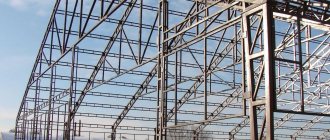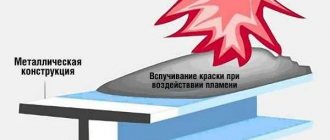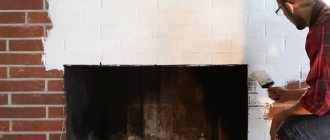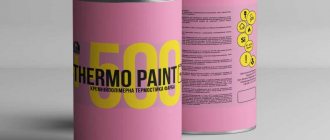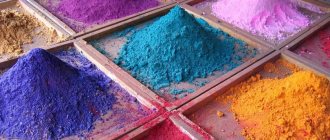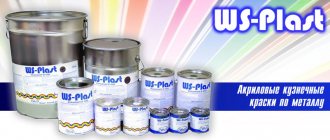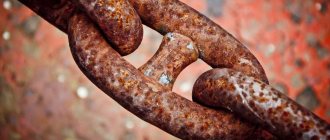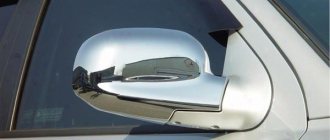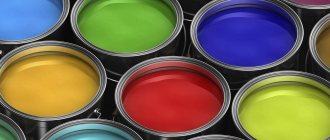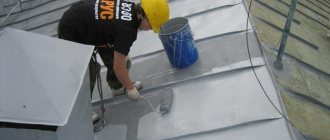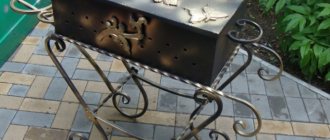Scope of application of heat-resistant paints
In domestic conditions, heat-resistant paints are widely used to paint heating and sauna stoves, barbecues and fireplaces, radiators and other elements of the heating system.
At enterprises for various purposes, they are used to protect equipment, pipes, and various structural elements that must constantly withstand high-temperature exposure. Heat-resistant compounds perform several main tasks:
- protective - they protect painted surfaces not only from thermal effects, but also from corrosion, and some of them are resistant to aggressive acidic or alkaline environments;
- decorative – provide painted surfaces with an attractive appearance.
Heat-resistant paint protects not only the surface itself. For example, if it is used to apply to a pipeline, it provides additional protection from heat to the substance that is pumped through the pipes.
Choosing between paint and varnish
The brick surface of fireplaces and stoves can be treated with paint or varnish. Both options have pros and cons.
Often brickwork has an attractive appearance that fits perfectly into the interior of the room. However, temperature changes, physical impact, and in baths - contact with steam, lead to damage to the top layer. Varnish is able to protect the masonry, leaving its pattern unchanged.
The surface treated with varnish takes on a “wet” tint. Therefore, the pale red color of the brick will become more reddish, and the white grout will become gray.
The varnish can be applied to the entire surface at once. This allows you to get the job done quickly and easily. When painting, if you use enamel and you need to preserve the masonry pattern, you will have to use a stencil and cover the grout, which is extra time and extra effort.
In addition, the varnish immediately helps to cover not only the brick, but also the masonry joints. This prevents the grout from crumbling due to thermal expansion. If enamel is used for painting, then you need to secure the seams between the bricks with a high-temperature sealant.
In the case when the surface pattern is not important, then paint, as well as varnish, can be applied in a continuous layer to both the brick and the grout. Black enamels are often used for baths, as they are most common in stores.
When painting a stove located in a bathhouse or sauna, it is necessary that the composition, after drying, can withstand the high humidity characteristic of rooms of this type.
The following article will introduce you to guidelines for choosing paint for restoring the external coating of radiators, which we strongly recommend reading.
Pros and cons of heat-resistant paints
The main advantages of heat-resistant compounds are:
- high efficiency - they provide reliable protection against heat and the resulting deformation;
- versatility - treated surfaces receive additional protection from other influences, for example from environments that can cause corrosion;
- elasticity - thanks to this feature, even repeated heating and cooling will not cause cracks in the coating;
- ease of application - heat-resistant paint can be applied in different ways, including paint, roller or using special sprayers, and there is no need to additionally train personnel; workers with painting skills can handle this task;
- durability - durable coating withstands external influences well, it is not afraid of sudden temperature changes and UV radiation, it does not need to be updated frequently;
- safety - when the coating heats up, it does not emit chemicals hazardous to human life and health;
- good decorative properties - as a rule, heat-resistant metal paints of various colors are on sale, and many of them can be mixed with colors to obtain the desired shade.
- The main disadvantage of such compositions is that they are usually more expensive than conventional paints. They also take a relatively long time to dry and often have a sharp, unpleasant odor that disappears only after complete drying.
How to dilute silver paint with your own hands
To prepare silver paint at home, you need to decide on the type of surface to be painted. For heating surfaces, it is necessary to choose heat-resistant enamel. To prepare it, PAP-1 powder is used, to which BT-577 varnish is added. If desired, you can purchase ready-made heat-resistant silver BT 177.
You should also decide which tool will be used to apply the composition:
- brush;
- roller;
- spray gun.
When using a brush and roller, the consistency of the paint should be thicker. If you use a spray gun, you need to make it more liquid by adding a solvent. During work, it is necessary to ensure that no streaks appear on the surface.
To use a spray gun, white spirit or turpentine is added to the finished paint in a 1:1 ratio. All work is carried out as follows:
- First, elements of body protection are put on, which include special clothing, a respirator, goggles and protective gloves.
- After this, a container is prepared for diluting the composition.
- At the next stage, powder and varnish are gradually added and mixing occurs. This must be done until the composition has a homogeneous consistency.
- At the last stage, a solvent is added. To better mix all the ingredients, you need to use a construction mixer.
Non-thermal paint is created in the same way. The only difference is in the components used.
Features of heat-resistant paint for calipers and mufflers
Heat-resistant dyes are used to process car parts made of metal. Moreover, the coating performs not only a decorative function.
The use of heat-resistant paint for the muffler, drums, calipers and other elements provides additional protection and also improves the performance of the machine. In large cities, in winter, roads are sprinkled with reagents aimed at combating ice. Such aggressive substances can cause corrosion of metal parts of the car that come into contact with snow or water.
Thanks to the dye, the heat transfer of the machine's calipers increases. The fact is that these elements have a porous surface, where dirt inevitably accumulates. As a result, the cooling time increases significantly. In addition, the process of cleaning the unit without removing the wheels is difficult. After processing the parts with heat-resistant dye, a smooth coating is formed on the surface, improving heat exchange and preventing the accumulation of dirt. And the process of cleaning the unit can be easily accomplished with a small stream of water.
Heat-resistant paint can be used for calipers, engine and other parts of the car
Dyes for treating metal car parts come in three forms:
- Spray can (aerosol spray).
- Jar.
- Set.
Characteristics of the compositions
Heat-resistant mixtures must have certain composition characteristics. Under the influence of temperatures, the material tends to stretch, which means that most coatings will simply peel off or crack. Only then can the paint be considered truly high quality. Such features of heat-resistant compounds include:
- strength while maintaining plasticity properties so that the coating does not stretch or crack when heated. Otherwise, paint peeling will begin after the first heating;
- good protection against corrosion, which is especially important when painting a stove in a bathhouse. The better the coating resists moisture, the longer it will last;
- low susceptibility to sudden changes in temperature conditions;
- abrasion resistance;
- easy application;
- increased adhesion parameters;
- inertness, both in the physical and chemical sense. The coating should not react with the surrounding aggressive media;
- electrical insulation parameters - important when applied to surfaces that must pass current.
Such paint characteristics are obtained only due to the special composition. Paints and varnishes with similar properties are widely used for application to fireplaces, heating stoves, radiators, as well as heating system pipes and various deep fryers, barbecues, and barbecue devices.
Due to their properties, paint coatings with the characteristics under consideration are successfully used in: aircraft construction, automobile and machine tool construction, for painting roofing coverings and metal profiles.
Almost all parts in machine tools that can be subjected to extreme heat or even heat in industry are treated with paints and varnishes with high temperature parameters.
Paints that are not classified as heat-resistant cannot withstand temperatures above 80°C. After such exposure, the coating easily peels off and cracks.
Important to know: What paints to use for exterior work
Advantages and popular brands
Heat-resistant paint can be found both in aerosol cans and in cans, buckets and even barrels.
The advantages of such compositions include:
- a high level of electrical insulation is an important point if you plan to paint metal products that transmit current;
- protection against corrosion - thermal paint can reliably protect metal from moisture;
- plasticity (when heated, the metal expands, the coating also stretches and does not crack);
- resistance to aggressive environments.
Currently, there is a huge range of similar paints on the market, among which you can find an option for almost any occasion. Depending on the manufacturer, each of them has a specific composition, its own characteristics and features, as well as cost.
- Heat resistant Certa. This enamel can be painted even in cold weather; it is designed for the range from -65 to +900 degrees. Black enamel can withstand up to 900 degrees, for others this figure is lower.
- Termal. Alkyd resin acts as a base. Available in silver and black. Suitable for use in bathhouses and similar premises, the coating lasts three years or more. After painting, you need to warm up the surface and let the applied composition dry - this is how the coating polymerizes.
- Hansa. The palette has sixteen shades.
- Kudo. This organosilicon thermoenamel is manufactured in Russia. Capable of withstanding up to 600 degrees. Available in twenty shades, sold in 520 ml cans.
- Hammerite. Can even be applied to rust on top, unlike other brands. But it is not petrol resistant.
- Bosny. This heat-resistant aerosol is available in two versions: 200 degrees and 650. Good durability, suitable for different surfaces.
- Elcon. Suitable for almost all oven materials. Retains its properties at a temperature of 800 degrees. Very large selection of colors.
- Rust-Oleum. Heat-resistant paint for metal up to 1000 degrees (and even up to 1100). Provides protection against gasoline and oil. Sold in aerosol cans, available in grey, black and white, as well as a transparent version that gives the surface a matte finish.
- KO-8111 Thermal. Withstands temperatures up to 600 degrees. Suitable for stoves and fireplaces in bathhouses. Has good water resistance.
Composition of fire-resistant dyes
The main difference between heat-resistant paints for metal and conventional ones is that fire-resistant paints contain pigments based on substances that are resistant to elevated temperatures.
Most of these dyes contain up to 50% titanium dioxide. Which has a melting point of +1855 degrees and, when added to the paint, reliably binds its components into a homogeneous mass, preventing it from igniting.
Ferrous oxide is added to the mixture, which is not subject to decomposition at high temperatures, and, like titanium oxide, allows the components in the composition to be more tightly bound. Heat-resistant paint contains chromium oxide, which increases its viscosity and color stability when exposed to high temperatures.
The listed elements are combined using a liquid base, which may consist of synthetic or organic non-flammable substances. This composition is used to treat metal surfaces that can be heated up to +1000 degrees.
If it is necessary to paint metal products that will not heat above +200 degrees, then in this case it is possible to use high-temperature paints based on epoxy resin.
Scope of application
High-temperature paint for metal is used for painting:
- heating radiators,
- internal combustion engine parts,
- stoves, boilers, fireplaces and various outdoor cooking equipment.
High temperature colors can be used in production. For example, in the production of drying chambers, roofing materials or machine tools, and at home during the independent construction of fireplaces or stoves.
Regardless of the scope of application of high-temperature paint, it is necessary to know exactly what criteria are used to select a high-temperature paint composition.
How to choose the right one
Only correctly selected paint will allow high-quality painting of a metal element that is operated at elevated temperatures.
To paint a solid fuel stove, it is also necessary to use fire-resistant dyes. If you ignore this rule, then with significant heating, ordinary paint will not only lose its aesthetic appearance, but can also cause a fire.
When painting parts of stoves and fireplaces, it is necessary to determine whether they are made of non-ferrous or ferrous metal. What type of surface the paint composition is intended for is usually indicated on the packaging, so you should study it very carefully when purchasing the product.
Video:
How else to protect a metal grill from rust?
A procedure such as oxidation or bluing can also protect a metal product. It is performed in factories; it is not easy to carry out a similar procedure at home. You can really do this with your own hands only with collapsible structures.
First, all parts are immersed in a 5% sulfuric acid solution for 5 minutes. After this, an aqueous solution with soap shavings is prepared, in which the parts are boiled for 10–15 minutes. After this treatment, the parts are not wiped or dried. They are treated with caustic soda (caustic soda) heated to 100°C. The grill should be kept in the solution for at least 2 hours. The parts can then be removed and allowed to dry.
After this treatment, a strong film is formed on the grill, thanks to which it will no longer burn. There is no risk of rust for the oxidized product. True, this method requires a lot of effort, so it is much easier to paint the product.
Thus, by choosing one paint or another, you can significantly improve the appearance of your favorite cooking product. I recommend watching the following video to take into account the experience of those who have already done this.
Types of heat-resistant coatings
The most popular are high-temperature finishing materials in the following forms of release:
- heat-resistant enamel in a jar or bucket;
- heat-resistant spray paint in cans.
One form or another should be used depending on the location of treatment and personal preference. It is convenient to apply the enamel with a roller over a large area, and aerosol paint will help you reach corners and hard-to-reach places.
Manufacturers produce heat-resistant paint on different bases. They differ in their basic properties, scope, ease of application and safety. On store shelves you can find the following coatings:
- acrylic;
- alkyd;
- epoxy;
- silicone.
Oil-based paints should not be applied to a surface that is heated, since when exposed to high temperatures they release harmful volatile substances with a characteristic unpleasant odor.
What is better to choose
To preserve the appearance of stoves or fireplaces with a stone design, it is advisable to use a heat-resistant transparent varnish. It will emphasize the surface texture and color of the material, natural or artificial.
The coating on a small surface area can be applied using paint in an aerosol can. It dries quickly and does not require any skills in working with paints and varnishes. The spray is easy to apply to hard-to-reach and uneven surfaces. Compositions produced in the form of aerosols do not require pre-treatment of the materials being painted.
If at your dacha there is a need to paint a stove located outside, the best choice would be paint labeled KO-8101. It is resistant to weather conditions and can be used even in winter.
Please note: Detailed instructions for reviving old furniture with your own hands
The use of latex water-based paints with heat-resistant characteristics makes it possible to impart water-repellent properties to the surface of the stove. It is advisable to use such a water-based coating in the kitchen.
Acrylic heat-resistant coating
Acrylic compounds are the safest for treating indoor surfaces. But such materials do not have very good resistance to high temperatures. They usually withstand temperatures up to 100 degrees.
Acrylic compositions are used to coat elements of heating systems, for example, metal radiators, gas boilers. Their advantages include:
- no pungent odor;
- good adhesion to the surface;
- rust protection;
- uniform application, no smudges;
- wide selection of colors;
- resistance to moisture and dust.
Apply acrylic heat-resistant finishing materials to degreased and dry surfaces using a brush. Since they dry very quickly, it is better to do this on a cold surface.
Tips for choosing
The result of the work will meet the stated requirements and you will not have to spend extra money if you follow certain tips:
- Each surface to be painted requires a different type of dye. For example, acrylic is only suitable for painting wooden, glass and plastic substrates. For metallic materials, compositions containing zinc and aluminum will be required.
- If the design requires the creation of a certain style, you can use paints with special effects that imitate dents or a hammer blow.
- Follow the information on the paint packaging when calculating the consumption of the heat-resistant mixture per square meter.
In particular, clarify the consumption per square meter, the resulting color based on the outcome and the number of layers required.
Despite the undeniable advantages: ease of application, lack of special preparation of surfaces and the ability to work with paint, the ability to protect the product from moisture cannot be considered universal for all construction work.
Therefore, during operation, the layers of the product should be updated.
Alkyd heat-resistant coating
Alkyd heat-resistant enamels can withstand heating temperatures up to 150 degrees. Based on this, they can be used for exterior finishing of stoves in places where there is no risk of fire, or indoors for painting radiators.
It is important to consider that alkyd compounds have a pungent, unpleasant odor, so they must be applied to a cooled surface. Among the advantages of this type of thermal coating:
- Can be used on any surface, high level of adhesion;
- service life up to 10 years;
- protection of the surface from external influences.
The alkyd composition should be applied to the surface in two layers so that the color is more uniform. It is convenient to use a brush to work with it, but some manufacturers produce an alkyd aerosol. Although it can be used to quickly paint hard-to-reach places, the material consumption in this case increases significantly.
Kinds
Types of heat-resistant paint:
- Acrylic and alkyd. The compositions are supplemented with various chemical components to change the basic qualities of the enamel. The finished coating can be heated up to 100°C. The composition does not emit harmful substances during operation and protects the metal from rust formation.
- Epoxy. The composition consists of two components, which are mixed immediately before use. The mixtures are supplemented with zinc phosphate and zinc to improve heat resistance. Other advantages are additional protection of surfaces from rust formation and high resistance to mechanical stress.
- Silicone. They are often used in various areas of industry. Resistant to heat up to 650°C. They are distinguished by elasticity, color saturation, and rapid hardening.
In nuclear energy, specialized heat-resistant coloring compositions made from organosilicon components are used.
Epoxy heat resistant coating
Epoxy thermal paint is designed for coating surfaces exposed to heat up to 400 degrees. They add special metal chips to their composition, which enhances resistance to high temperatures.
Epoxy paint is suitable for stoves, fireplaces, and barbecues. Its great advantage is its good adhesion to surfaces made of metal, brick, and natural stone. In addition, it has other advantages:
- preventing the formation of corrosion;
- super strength, resistance to abrasion and other mechanical stress;
- service life up to 15 years.
Epoxy high temperature paint is safe, so it can be used both indoors and outdoors. It belongs to two-component finishing materials, so before starting work, you need to mix it. This is very convenient, as you can control the consumption yourself.
Heat-resistant paint for a barbecue or metal fireplace grate is applied to a previously sanded surface. When working with brick coating, it should be treated with a special epoxy primer.
Surface preparation
For all the paints described, there are general instructions for the preliminary preparation of surfaces. To improve adhesion to the base, the following preparatory measures are carried out:
- clean the product to be painted from dirt, dust, salts, grease and other contaminants;
- remove all existing rust, as well as paint that does not adhere well to the surface (all or individual areas);
- cleanse to degree St3, SA2-2.5 according to standards;
- Before painting work, degrease the base with solvent or xylene, start painting no later than after 6 hours in an open area, after 24 hours - in a closed room.
The main condition for a high-quality result is the presence of a completely dry and clean base, then the material will lie smoothly and have good adhesion.
Silicone Heat Resistant Coatings
Silicone heat-resistant paint for metal, depending on the composition, can withstand temperatures from 200 to 1000 degrees. To increase heat resistance, manufacturers add metal powder and heat-resistant glass chips.
These finishing materials form an elastic layer of coating on the surface that is resistant to mechanical damage, moisture and corrosion. Silicone heat-resistant paint is not used for stoves and fireplaces made of stone and brick.
The advantages of this coating include:
- drying speed from 1 hour, depending on temperature and humidity;
- color fastness;
- elasticity;
- service life up to 10 years, depending on operating conditions.
Before you start painting the barbecue, stove or fireplace parts, you should treat all metal parts with a primer. It will significantly improve adhesion and anti-corrosion properties. If paint is applied to a surface that is heated to a temperature of 1000 degrees, it must be sandblasted, thus ensuring adhesion of the metal to the coating.
You should not use these finishing materials yourself without the supervision of a specialist. Although they are easy to apply to the metal surface, for complete hardening it is necessary to heat the coating using special equipment.
Recommendations for use
The metal is painted in 2-3 layers.
In order for the heat-resistant paint to show all its properties, you need to choose it correctly and use it. The recommendations are as follows.
- For large volumes of work, it is preferable to spray enamel. To do this, select compositions with sufficient fluidity and use a pneumatic sprayer.
- It is recommended to paint metal surfaces in 2–3 layers, which are applied crosswise.
- If painted objects are used at temperatures above +400 ° C, paint in 1–2 layers. Thickness is at least 30–50 microns.
- Concrete, plastered and brick surfaces are painted in at least 3 layers. They must be well dried.
- The shelf life of the paint is on average 7 months. However, it is better to clarify this indicator by examining the packaging.
Fire-resistant paint for metal can only be used for painting steel, aluminum and other alloys. The composition for wood is used only for wooden surfaces.
How to use it correctly?
To prepare the surface for painting, it should be cleaned of dirt, rust, old paint, oil or grease. Mechanical or manual cleaning can be carried out. Surface treatment is carried out to degrees St 3 or SA2-SA2.5. The letters St indicate that it is cleaned manually or mechanically, using a brush. Before cleaning, all rust should be scraped off the surfaces and any remaining oil and dirt should be removed. After all contaminants have been removed, dust removal is carried out.
Blasting is designated by the letters SA. Grade SA2-SA2.5 requires very thorough surface cleaning. During the inspection, no oil residues, rust, paint or other contaminants should be detected.
After the surface is completely cleaned, it should be degreased with a solvent; “Solvent” or “Xylene” may be suitable for this. The surface should be degreased before work. After treatment, the product should not be kept outside for more than six hours without degreasing and indoors for more than a day.
Before you start working with paint, you should check the surface to make sure it is not dirty or wet.
Preparatory stage
After opening the jar, stir the enamel thoroughly until the sediment disappears and wait ten minutes until the bubbles disappear. The viscosity of enamel can be measured with a special device, the VZ-246 viscometer; it is designed to determine a conditional indicator, that is, the expiration time of the paintwork material. Using “Xylene” or “Solvent”, you can dilute the paint to the desired consistency, but not more than 30%. At the end of the work, the jar is tightly closed and left for storage.
When working with solvents, it is important to know that they are quite toxic, so it is not recommended to apply Certa enamel inside a residential area.
Coloring
The paint is applied to the surface using a roller or brush. It should be applied in a thin layer; this determines how well the silicone film and metal adhere.
Using a spray bottle or aerosol can you can get a more uniform coating.
When using Certa aerosol paint in a can, you get a very smooth coating, but a lot of toxic substances get into the air. It is better to use this option for painting not very large objects, such as a grill, barbecue or muffler. It is important to carry out work in the fresh air, using products to protect against toxic substances.
Many heat-resistant materials do not require pre-treatment. The consumption of paints and varnishes will depend on the conditions under which they are used. When painting the walls of a chimney, two layers of enamel should be applied; when painting barbecues or barbecues, one is enough. Apply 2-3 thick layers on brick or plaster surfaces.
How to paint a barbecue correctly?
Repairing a barbecue grill requires careful preparation. You need to buy suitable paint, tools, and find a place where the whole process will take place.
It is correct to paint the grill in dry weather. The air temperature can be almost any. This should only be done in an open space or in a well-ventilated area: most heat-resistant dyes have an unpleasant odor.
Selection of paint and necessary materials
Construction stores offer a wide range of heat-resistant paints. When choosing such a product, you should give preference to compositions that can withstand heating temperatures of at least 600 degrees. Among the most popular heat-resistant paints the leaders are:
- "Tikkurila Termal". The mixture refers to silicone paints. Withstands temperatures up to 600 degrees. Failure to follow safety precautions during painting work can cause poisoning.
- "Cetra". Aerosol dye in a can. The coating is resistant to heating up to 900°C. Belongs to the alkyd group.
- "Elkon". The paint is organosilicon. Withstands heating up to 1000°C. Suitable for painting sauna stoves, barbecues, boilers.
Regardless of the type of dye, before you start working with it, you need to protect yourself from inhaling toxic fumes. To do this, you need to purchase a special respiratory mask. It is better to apply paint with a brush. The roller is used for this less often.
Another painting option is to immerse the device in a container with prepared dye. However, this method will not allow you to completely paint the sides of the product, so you will have to finish painting the top part with a brush.
How to prepare a surface for painting?
Anyone can renew a metal grill with their own hands so that it does not burn or rust. Regardless of the type of dye, the product should be prepared before dyeing. To do this, you need to clean off soot and carbon deposits from it, and remove rust. Doing this manually will take a very long time, so it is better to use a grinder with brush attachments. The cleaned surface should be degreased using acetone or white alcohol. Then the product needs to be dried.
How long does it take for a painted surface to dry and when can you use the grill?
The drying time for a painted barbecue depends on what type of paint is used. Usually the paint is applied in 2-3 layers. Each of them should dry for at least half an hour. On average, already 10–12 hours after finishing work, the product can be safely touched with your hands and, if necessary, moved. You can fry kebabs on the updated device a day after it has dried.
Top fireproof paints for metal up to 1000 degrees
To protect a heating radiator, metal stove or other objects from corrosion and aggressive external influences, they are coated with heat-resistant paint and varnish enamels. The paint and varnish coating can withstand up to 1000 degrees C. Enamel not only protects, but also gives an aesthetic appearance.
Making a choice in favor of one paint or another is difficult. A fresh coating will give the products a new appearance. We have compiled for you a rating of the most popular paint coatings. All submitted candidates have been verified by operational practice and experience.
Tikkurila termal silikonimaali
Country of origin: Finland and Russia. Used for painting metal products. Based on silicone resin. Suitable for indoor and outdoor use. Resistant to high temperatures up to 400 degrees. This property provides protection for chimney pipes and dampers. Used for painting car muffler. Black color. After drying, a semi-matte shine is formed. Protects the metal structure.
Apply with a brush or spray. Complete drying time at a temperature of +230 C is exactly 1 hour. You can use cleaning products to wash the surface after one month. One liter of enamel is designed for 16-20 square meters. If the paint is applied in one layer. The price corresponds to the quality. The only minus is heat treatment after application to ensure complete drying.
Celsite-600
Black paint. Withstands temperatures up to +600 degrees. High degree of protection when using metal under the influence of high temperatures and moisture. Resistant to the influence of petroleum products, oil, gasoline. Used for painting: electric motors, transformers, household heating appliances, bridges, tanks, metal structures, railway tanks, calipers. Can be applied to reinforced concrete, asbestos-cement, brick, plastered surfaces. The enamel is applied in three layers. The color is black, the surface acquires a matte tint.
Certa KO-85
Certa is used for items that operate at temperatures from -50 to 900 degrees C. Heat-resistant enamel. Tolerates temperature changes well, including high temperatures. Protects against aggressive environments and high levels of humidity. Prevents corrosion and moisture ingress. Apply at minus 30 degrees Celsius. Transparent paint material. Used instead of varnish to coat brick, concrete, and ceramics. Apply in three layers to achieve a matte finish. In one layer, the brick acquires a wet effect.
Elcon
To obtain the desired color it is mixed with colorant. At the same time, the pigment contained reduces the level of protection and durability of the painted coating.
The color palette is very rich. The gloss can be matte or glossy. A product painted in classic black can be heated up to 1000. And all other colors are not higher than 700 degrees. You can create beautiful patterns on the walls using a stencil without involving specialists. In addition to metal surfaces, it protects concrete, brick, and asbestos products from the influence of aggressive environments.
Kudo
The composition does not contain toxic components. When used, harmful substances are not released into the air. Can be used inside a living room, stove or fireplace, chimney. There is no need to apply a primer before application. Complete drying time 2 hours. It is considered slightly flammable and difficult to ignite. The room temperature is not lower than +3C. Service life is at least 20 years. Universal, can be used on products of different surfaces.
Dali
Matte paint for interior and exterior work. Used for painting car exhaust systems, chimneys, and chimneys. Black color. Before opening the can, the manufacturer recommends stirring the contents well. Apply by brush or spray. Drying time from 1 to 3 hours. If you want to apply several layers to the product, then the time interval for each layer is 1 hour. Thermal curing for 2 hours at 200 degrees.
Heat-resistant silver oxide Novbytkhim
Heat-resistant universal. Used for glass, brick, concrete, plaster surfaces. The resulting layer protects against oil, gasoline, water, and steam, salt fog in the range from – 50 to +600 degrees Celsius. Withstands sudden temperature changes, but within the range indicated on the package. The enamel is waterproof and dries quickly. Apply no more than three layers. Stir not only before application, but also during application. Pre-prepare the surface. Clean from dust and dirt. Contains organic substances.
Bosny Hi-Temp (color)
Acrylic-based paint with silicone pigmentation from Bosny has a lower permissible temperature than black or silver. It is characterized by good quality at an average price for products of this class.
Due to the lower permissible temperature, the scope of application of Bosny Hi-Temp color paints is slightly different than that of black or silver composition
Main parameters:
- color: red, orange, yellow, green, blue;
- gloss type: matte;
- maximum temperature (0C): 205;
- type of packaging and volume (l): can (0.4);
- Country of origin: Thailand.
The most common area of application is painting pipes and heating radiators. It is also used for decorative painting of car parts. It dries quickly, does not peel off, but requires thermal hardening. Thus, it is better to paint the batteries a day or two before turning them on.
One can is enough to paint 1.5-2 m2 of surface in 2 layers. In addition to sanding, it is advisable to prime the surface. This will significantly increase its resistance to physical damage.
Veslee
Heat-resistant, high-quality metal paint on an acrylic-epoxy base is in the middle price range.
Small capacity cylinders (0.1 l) are used for painting automotive parts. To treat the heating system, it is financially more profitable to take a standard volume (0.52 l) packaging
Main parameters:
- color: black, white, red, silver;
- gloss type: matte;
- maximum temperature (0C): 400 (black), 250 (all others);
- type of packaging and volume (l): can (0.1, 0.52);
- Country of origin: China.
The composition is intended for painting heating circuit elements (excluding fireboxes) and automotive parts (mainly the exhaust system). The availability of small-volume cans for sale is a definite plus when you need to paint a surface with a small area.
The paint is quick-drying - the drying interval between layers is 2-3 minutes.
MagicLine
Spray paint made in China, based on synthetic resin, is located in the middle price range. According to consumer reviews, the temperature indicated on the label is not the maximum allowed for an indefinite period of time, but acceptable for a short-term period.
The most ordinary paint made in China, without any significant pros and cons. Available as an aerosol can
Main parameters:
- black color;
- gloss type: matte;
- maximum temperature (0C): 600;
- type of packaging and volume (l): can (0.4);
- Country of origin: China.
Medium quality products designed for processing metal parts. Not suitable for application to high temperature objects such as the firebox door of a steel oven or hob.
Thermoxol
Russian-made paint is intended for metal surfaces. It is distinguished by good quality, four main colors, packaging of varying volumes and an average price.
If you need to process a lot of radiators and pipes, then it is better to take paint in buckets - it will be much cheaper
Main parameters:
- color: black, white, red-brown, gray;
- gloss type: glossy;
- maximum temperature (0C): 160;
- type of packaging and volume: jar (0.9), bucket (3, 10, 20);
- country of origin: Russia.
The paint contains formaldehyde resin and an acid thinner, so the area must be well ventilated. It can be used for processing ferrous and non-ferrous metals, as well as alloys. The composition can be applied to tightly adherent rust.
Short-term (up to 5 hours) heat resistance – 2100C. The main purpose is painting heating radiators and pipes.
Decorix
This enamel can often be found in stores and retail outlets. It has a low price and acceptable quality.
This cheap enamel is best used for painting sauna stoves and other metal products whose appearance is not particularly important.
Main parameters:
- color: white, aluminum, black;
- gloss type: glossy;
- maximum temperature (0C): 800;
- type of packaging and volume (l): can (0.52);
- Country of origin: China.
Decorix enamel is available in the three most popular colors for metal coating. The mass fraction of paint for such a volume is insignificant - only 0.315 kg (usually 0.34 - 0.36 kg).
The sprayer leg is soldered into the can, so if the composition dries out, it will not be possible to replace the mechanism. Therefore, it is better not to leave partially used paint for a long time.
General rules of application
The question of the method of application and rules of operation of the compositions deserves special attention. The basic concepts when working with heat-resistant paints are preparation, application, calcination. Technologists recommend properly preparing the surface. The strength of adhesion and the quality of the finish after exposure to temperature depend on this.
Preparation includes the following steps:
- removal of contaminants;
- cleaning corroded areas;
- grinding;
- priming, if necessary;
- complete degreasing of the surface.
Before you start painting the surface, you should make sure that it is completely dry. Paint-and-varnish compositions are applied only to a dry and grease-free surface. The application method depends on the type of paint. The work is carried out using aerosols; for large surfaces it is recommended to select alkyd or silicone paints, which are applied with a roller or brush.
Attention! When applying, you must use protective equipment: suit or apron, gloves, glasses, hat.
Expert opinionZakharova Irina YuryevnaProfi in cleaning with 15 years of experience. Our best expert. First of all, paint is applied to hard-to-reach places: corners, seams, joints. Large areas are then painted. To ensure strong adhesion and ensure an even finish, layers are repeated 2 times.
Calcination is the last stage, which involves artificially heating the area. Calcination is started after the natural hardening of the pigment. The stove, pipes or fireplace are heated at an acceptable temperature for 3 hours. It is recommended to increase the temperature gradually, increasing the load on the coating in stages. This technique helps to better consolidate the created finish, increase protective properties and increase resistance to temperature effects.
Surface preparation and painting
The preparatory stage is simple, but all stages must be completed. Otherwise, you will get a low-quality result that will not last long; the cost of many paints is high, so it is irrational to waste them. As a result, before painting you need to get a surface free of dirt and any impurities.
Perform the following actions:
- The surface is cleaned with a metal brush.
- Eliminate existing oxides using a 5% concentrated solution of sulfuric acid.
- Then the solution is removed using laundry soap.
- The oven is degreased.
Before painting, check the expiration date and quality of the paint and varnish; it is important that there are no lumps or unnecessary impurities. The composition is thoroughly mixed so that all sediments from the bottom are evenly distributed.
Before painting, check the expiration date and quality of the paint and varnish; it is important that there are no lumps or unnecessary impurities.
It is necessary to achieve an even layer, paying special attention to corners and seams. In order not to stain nearby objects, you can first cover them with film.
The tool you can choose from is a brush, roller and spray gun. If the oven is small, then a brush is enough. The spray bottle cannot be used with all formulations; please refer to the manufacturer's instructions. The walls of the stove can be painted well with a brush, but it will be easier to cover the fittings evenly with an aerosol.
The drying process for paints is different; to find out when you can light the stove after painting, you need to read the manufacturer's recommendations. This usually requires waiting 3-4 days.
It is better to take your time in this matter so that the paint can set well and serve for a long time, reliably protecting the metal surface from moisture and high temperatures.
It will be easier to cover the fittings evenly using an aerosol.
Preparation for painting and application methods
The surface is first prepared. The requirements for the surface to be painted are usually described in the instructions for the composition. Some marks can be applied without any prep work, but in most cases you will need to do the following:
- The surface is degreased, cleaned of old coating and salts.
- Remove rust. There should be no rust stains left, and the metal surface should acquire a silver color. For processing, use a wire attachment on a grinder or regular sandpaper. You can use sandblasting.
- Then the surface is washed and dried. Using a solvent, the surface is completely degreased. After degreasing, you need to wait six hours if the work is carried out in the air. You need to wait a day indoors.
- Then the coloring composition is applied. There can be several layers of application; in this case, it is better to apply them in different directions - this way, a better finish is achieved.
Paint is applied to the surface in three ways:
Consumption directly depends on the method of application. If the composition is applied with a brush, then the consumption will be 10-40% more than in the case of an aerosol, while the durability of the coating will be approximately the same.
Before work, you need to carefully read the instructions and comply with all painting conditions: temperature conditions, drying conditions, time intervals between applying a new layer. Then the paintwork will last a long time, maintaining its properties.
Aerosol paints in cans are designed for painting small parts and surfaces in hard-to-reach places.
These disposable materials are also used for decorative and restoration work, as well as for the production of stencil designs and graffiti.
They are made in the form of containers (paint cylinders) filled with gas and dye under pressure.
Features of painting a metal stove
To get maximum efficiency from using high temperature paint, the painting process should be carried out according to the rules. First of all, study the instructions on the package. And then the metal stove is prepared, and only then proceed to painting.
To get maximum efficiency from using high temperature paint, the painting process should be carried out according to the rules.
Coloring stages
The painting procedure includes the following steps:
Clean the surface of the stove using sandpaper or a stiff brush. This will allow the paint to adhere better. If rust is present, treat with a 5% sulfuric acid solution. When processing, you should protect your hands with gloves, and use a brush for application. Remaining acid should be washed off with a soap solution (50 g of laundry soap per liter of water). If there is no rust, you can skip this step. Apply a degreasing agent (solvent, white spirit) or simply wash the oven with soap and let it dry thoroughly. Heat-resistant paint is applied using a spray or brush. For greater stability, apply two or three layers, drying completely each time.
It doesn’t matter what material the stove is made of, iron, steel or cast iron, the process is the same. Before working with the aerosol, shake the can for a minute, after which you proceed to spraying
The mixture to be painted is applied from a distance of 20-30 cm to make a thin layer.
Do-it-yourself thermal paint, can it be done and how?
You can make heat-resistant paint yourself. The best option would be to prepare it from liquid glass and aluminum powder. The main thing is to understand that after the first fire, strong smoke may appear; the shelf life of such a coating is up to five years.
You can also use heat-resistant varnish; aluminum powder is added to it to obtain the desired effect. This option can withstand up to 350 degrees, and receives an anti-corrosion coating. Making paints is not difficult, the main thing is to get the necessary ingredients.
You can use heat-resistant varnish; aluminum powder is added to it to obtain the desired effect.
Types of solvents
The separation of the agents used to dilute enamel paint occurs according to the rate of their evaporation after administration. In this case, the parameter takes into account standard conditions. So there are the following types:
- Refractory;
- Medium volatile;
- Highly volatile.
There are a large number of solvent compositions on sale. Many of them have not lost popularity for many years: gasoline, xylene, acetone, white spirit and others.
There are a large number of solvent compositions on sale.
Labeling and classification by field of application
Depending on their temperature characteristics, all fire-resistant paints are divided into the following categories.
- For industrial use - where temperatures can rise above 700 degrees, paints made from silicone resins are used.
- In domestic conditions, the temperature often does not exceed 100 degrees. Here, paints made from alkyd or acrylic resins are used, which make it possible to create a high-quality monolithic layer. As a rule, water heaters and heating radiators are painted with such paints.
- The next type of paint is designed for a temperature range from 400 to 750 degrees. They are produced mainly in cans in the form of an aerosol or spray.
- Paints designed for temperatures within 100-120 degrees. They are made from epoxy resins.
- Single-component paints, designed for temperatures in the range of 200-400 degrees. They can consist of either ester-epoxy or ethyl silicate resin.
Note! On the cans in which fire-resistant paints are sold, you can find markings consisting of numbers and letters. The abbreviation KO, for example, indicates that the paint is based on an organosilicon binder. The first number after the abbreviation indicates the degree of heat resistance (say, 8), while all subsequent numbers are just the design number in the catalog.
Below is a breakdown of the markings of heat-resistant enamels.
- KO-811 is an excellent product for protecting steel and aluminum surfaces from corrosion. It differs in that it can be applied even at sub-zero temperatures. As a result, you can get an environmentally friendly coating that is resistant to humidity and temperature changes (by the way, at high temperatures the surface only becomes stronger).
- KO-8111 – paint for metal structures heating up to no higher than 600 degrees. This enamel is especially resistant to various aggressive environments.
- KO-814 can withstand temperatures from minus 60 to plus 400 degrees. It has increased resistance to saline solutions, petroleum products and mineral oils. Used primarily when painting hot steam lines.
- KO-813 is an enamel that effectively protects metal surfaces and can withstand temperatures from 60 to 600 degrees. Protects the material from corrosion and is immune to humidity and temperature changes.
Types of fire-resistant paints
High-temperature paint is classified according to its permissible heating temperature . However, this ability is determined by its composition. Based on the type of binder, the following options are distinguished.
- Alkyd is the least stable. Provides protection when heated to no more than +150°C. Used for painting the bodies of ceramic stoves, radiators and heating pipes. Features a long service life.
- Acrylic – designed for working on metal, applied in a thin layer. Waterproof, protects steel from corrosion. Withstands heating up to +100°C . Used for painting heating systems. It is odorless, dries quickly, and is safe for humans and pets.
- Epoxy – allows heating up to +400°C . It has increased adhesion to any type of surface, is durable, and does not emit toxic substances. It is used for painting stoves, fireplaces, portals, and barbecues.
- Silicone is heat-resistant, most resistant to temperature - up to +1000°C . Dries quickly - within 1 hour, elastic, not afraid of water and sun. Used for finishing metal surfaces only.
- Organosilicon heat-resistant facade enamels are also produced It can withstand heating up to +300°C . Used as a reliable anti-corrosion coating.
Heat-resistant compositions are produced in accordance with GOST and TU. The color range of the former is very limited.
Criterias of choice
When choosing a paint, you need to take into account the base material and the maximum heating temperature.
To choose the right paint composition, consider the following.
- Heating temperature – even acrylic composition is suitable for painting the battery, since the device does not heat up much. To finish the inner surface of the fireplace you need a fire retardant compound.
- The nature of the surface – enamels are specialized. Epoxy is used to paint brick fireplaces and chimneys. Silicone ones “work” only on metal surfaces.
- Wear resistance - the stove coating wears out little. Paint for automotive parts must be very durable.
- Safety - for indoor work, and even more so in baths and saunas, only mixtures that do not release toxic substances when hardened are suitable. It is better to choose odorless paints.
Enamel is produced in the form of an aerosol or a liquid mixture in jars and buckets. The first option allows you to apply the paint in a thinner layer - glossy or matte. Sometimes it's important.
